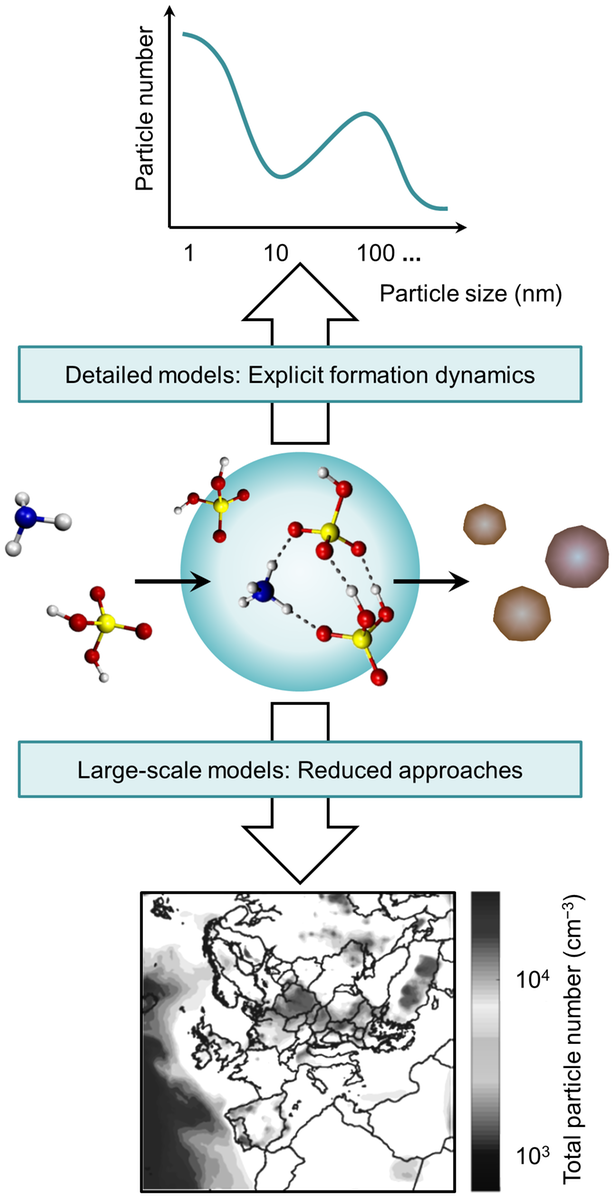AeroFrame and AeroSources – Advancing predictions of atmospheric aerosol formation
Research projects focusing on the formation of secondary aerosol particles from gases provide new tools for describing the formation dynamics.
Formation of small airborne particles from condensable gases is a ubiquitous process in the atmosphere. These secondary particles make a substantial contribution to total ambient aerosol numbers, and have effects on cloud formation and climate as well as human health. The precursor gases, including acids, bases and organic species, originate from both human and natural emissions such as traffic, industry, agriculture, vegetation and sea. Reducing uncertainties related to the formation mechanisms is a central question for assessments of aerosol sources and effects.

Aerosol particles affect cloud formation by acting as condensation seeds for clouds.
Building model representations is, however, challenging: On one hand, detailed models are needed for understanding the complex physical and chemical processes that determine the numbers of formed particles in different environments. On the other hand, complicated and detailed schemes are not feasible for large-scale climate and air quality models, which instead require simplified but robust approaches.
These needs are addressed by two projects at the SMHI Meteorology research unit:
- AeroFrame: Explicit framework from molecular clusters to nanoparticles for resolving atmospheric aerosol formation dynamics, and
- AeroSources: New generation tools for robust quantification of atmospheric nanoparticle sources.
The projects aim to build reliable and easily applicable model tools, with the following main goals:
- To create a novel framework for explicitly resolving the formation dynamics, from the initial agglomeration of gas molecules to the growth of the newly-formed particles by vapor uptake. Such approach is needed for quantitative assessments of nanoparticle concentrations.
- To construct and evaluate approaches for simplified application of particle formation rates in atmospheric models. This enables straight-forward incorporation of molecular model predictions in large-scale models.
- To make the tools openly available to the atmospheric modeling community.
At present, the central model frameworks have been released and implemented in, for instance, air mass trajectory and global climate models. Results demonstrate promising approaches for simplified treatment of common formation mechanisms through e.g. sulfuric acid and ammonia. Pathways involving lower-level trace gases such as amine species, however, are likely to involve more uncertainties when treated in a very simplified manner.

Different model tools are needed for understanding the detailed mechanisms of particle formation from gases, and representing the process in large-scale models.
About the projects
The projects are active 2020–2023, and are funded by the Swedish Research Council Vetenskapsrådet, and the Swedish Research Council for Sustainable Development Formas.
Project manager
Tinja Olenius, SMHI Research for Meteorology – Environment and Climate
Project results
- New studies provide improved assessments of the chemical mechanisms of atmospheric aerosol formation
- Novel model methods indicate marine sources of secondary aerosol particles from sulfuric acid, ammonia and iodine with potential effects on clouds
New studies from the Meteorology Research Unit together with Lund University apply recently developed model tools to describe detailed aerosol formation processes in atmospheric models. These works contribute to resolving the roles of different gas species and the resulting effects on aerosol numbers and climate.
Publications
Open-source tools
Find the open-source tools created within the projects at
Aerosol particles and their role in the atmosphere
Aerosol particles are a central atmospheric constituent affecting air quality, cloud formation and climate. A significant fraction of aerosols are formed from condensable gases, but predictions of the secondary aerosol numbers and the exact chemical mechanisms of particle formation involve large uncertainties. Combinations of sulfuric acid and base species, most importantly ammonia, are known to be a central mechanism, but also other gas species may drive or enhance the formation processes. The gases are emitted by both human activities and natural sources: for example, traffic, industry and shipping are major sources of sulfur, and ammonia is produced by agriculture and animals. In addition, sea and vegetation are natural sources of precursor gases.
Model development enables description of molecular-scale phenomena
Formation of new airborne particles from gases occurs through gas molecules colliding and sticking together. This is a dynamic and complex molecular process, in which the small clusters of molecules grow by accumulating more molecules, but simultaneously also evaporate. These processes are actively studied within computational chemistry, which provides predictions of particle formation rates for different chemical species. However, such predictions have not been utilized in atmospheric models due to lack of tools to incorporate them.
The new model tools, developed at SMHI, enable transferring the molecular model predictions to atmospheric model frameworks in an optimal manner. In this way, the formation processes can be described on a detailed level, capturing the effects of gas concentrations, temperature and other environmental conditions.
Resolving marine aerosol formation is important for climate predictions
The practical applications of the tools study aerosol formation both in high detail along air mass trajectories, and on global scale. The detailed case studies focus on marine secondary aerosol sources over Antarctic regions and sub-Arctic boreal environments in Northern Europe. The results suggest that iodine species from the ocean can have an important role in the Antarctic together with natural sulfuric acid ammonia, which is relevant for possible future scenarios with less sea ice and therefore more iodine emissions. The marine precursor gases can also increase boreal continental aerosol levels: when air from the sea is transported over land, aerosol numbers increase due to particle formation from the marine species, most of all sulfur.
In the global climate model study, the sulfuric acid and ammonia pathway was implemented in an Earth system model to assess its effects on clouds and radiation. Large-scale models typically apply very simple parameterizations for particle formation rates, but the new approach introduces a more robust description which provides better representation in different types of environments. The pathway showed effects especially over oceans, with more climate cooling due to increased aerosol numbers and cloud formation.
Polar and marine environments are important for global climate, as these cleaner environments are more sensitive to changes in aerosol burdens and have notable effects on Earth’s radiation budget. Furthermore, understanding natural particle sources is essential for determining the effects of human activities. With the new model tools in use, effects of also other particle-forming species in different environments can be studied in a similar way.


